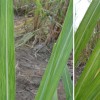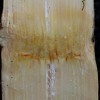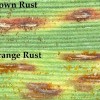
Ring spot, caused by the fungus Leptosphariea sacchari, is a disease of sugarcane that has been known to occur in Florida for over 80 years. Ring spot usually affects only the older leaves, and therefore is considered a minor disease. However, correctly identifying the disease in the field can help to reduce unnecessary chemical sprays. This two-page fact sheet outlines the symptoms and spread of the disease, as well as how to prevent and control Sugarcane Ring Spot. Written by P. Rott, J.C. Comstock, H.S. Sandhu, and R.N. Raid, and published by the Plant Pathology Department.
http://edis.ifas.ufl.edu/pp321
Tag: P. Rott
Sugarcane Mosaic
 Mosaic’s most distinctive symptom is a pattern of contrasting shades of green, often islands of normal green on a background of paler green or yellowish chlorotic areas on the leaf blade. It had not been a problem in Florida until 1996, when it was observed on CP72-2086, a major commercial cultivar, near the intersection of Hatton Highway and US 98. Presently, because of the limited acreage of CP72-2086, the disease is only a potential threat. This 3-page fact sheet was written by P. Rott, J. C. Comstock, R. A. Gilbert, and H. S. Sandhu, and published by the UF Department of Agronomy, February 2015. (Photo: Philippe Rott, UF/IFAS)
Mosaic’s most distinctive symptom is a pattern of contrasting shades of green, often islands of normal green on a background of paler green or yellowish chlorotic areas on the leaf blade. It had not been a problem in Florida until 1996, when it was observed on CP72-2086, a major commercial cultivar, near the intersection of Hatton Highway and US 98. Presently, because of the limited acreage of CP72-2086, the disease is only a potential threat. This 3-page fact sheet was written by P. Rott, J. C. Comstock, R. A. Gilbert, and H. S. Sandhu, and published by the UF Department of Agronomy, February 2015. (Photo: Philippe Rott, UF/IFAS)
http://edis.ifas.ufl.edu/sc009
Sugarcane Ratoon Stunting
 Ratoon stunting, also known as ratoon stunting disease (RSD), is considered by many sugarcane pathologists to be the most important disease affecting sugarcane production worldwide, because it can cause 5% to 15% crop yield losses without growers even realizing their fields are infected. This 3-page fact sheet describes the symptoms, causal agent, and prevention and control. Written by P. Rott, S. Sood, J. C. Comstock, R. A. Gilbert, and H. S. Sandhu, and published by the UF Department of Agronomy, August 2014. (Photo credit: Sushma Sood, USDA)
Ratoon stunting, also known as ratoon stunting disease (RSD), is considered by many sugarcane pathologists to be the most important disease affecting sugarcane production worldwide, because it can cause 5% to 15% crop yield losses without growers even realizing their fields are infected. This 3-page fact sheet describes the symptoms, causal agent, and prevention and control. Written by P. Rott, S. Sood, J. C. Comstock, R. A. Gilbert, and H. S. Sandhu, and published by the UF Department of Agronomy, August 2014. (Photo credit: Sushma Sood, USDA)
http://edis.ifas.ufl.edu/sc002
Sugarcane Orange Rust
 In June 2007, rust symptoms were observed on sugarcane cultivar CP80-1743 about six miles east of Belle Glade, Florida. The disease was confirmed as orange rust of sugarcane. It is hypothesized that rust spores were blown into the region as a disperse spore cloud from an unknown source rather than spread from a single or several small focal points. This 7-page fact sheet was written by P. Rott, S. Sood, J. C. Comstock, R. N. Raid, N. C. Glynn, R. A. Gilbert, and H. S. Sandhu, and published by the UF Department of Agronomy, May 2014.
In June 2007, rust symptoms were observed on sugarcane cultivar CP80-1743 about six miles east of Belle Glade, Florida. The disease was confirmed as orange rust of sugarcane. It is hypothesized that rust spores were blown into the region as a disperse spore cloud from an unknown source rather than spread from a single or several small focal points. This 7-page fact sheet was written by P. Rott, S. Sood, J. C. Comstock, R. N. Raid, N. C. Glynn, R. A. Gilbert, and H. S. Sandhu, and published by the UF Department of Agronomy, May 2014.
http://edis.ifas.ufl.edu/sc099